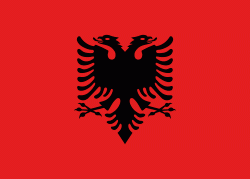Berat (Bashkia Berat)
Berat (Berati) is the ninth most populous city of Albania and the seat of Berat County and Berat Municipality. By air, it is 71 km north of Gjirokastër, 70 km west of Korçë, 70 km south of Tirana, and 33 km east of Fier.
Berat is located in the south of the country. It is surrounded by mountains and hills, including Tomorr on the east that was declared a national park. The river Osum (total length 161 km) runs through the city before it empties into the Seman within the Myzeqe Plain. The municipality of Berat was formed at the 2015 local government reform by the merger of the former municipalities Berat, Otllak, Roshnik, Sinjë, and Velabisht, that became municipal units. The seat of the municipality is the city Berat. The total population is 60,031 (2011 census), in a total area of 380.21 km2. The population of the former municipality at the 2011 census was 32,606.
Berat, designated a UNESCO World Heritage Site in 2008, comprises a unique style of architecture with influences from several civilizations that have managed to coexist for centuries throughout the history. Like many cities in Albania, Berat comprises an old fortified city filled with churches and mosques painted with grandiose wealth of visible murals and frescos. Berat is one of the main cultural centres of the country.
The name Berat has been derived through Albanian sound changes from the Old Bulgarian Bělgrad (Бѣлградъ) or Belgrád / Beligrad (Белград / Белиград), meaning "White City".
It is believed to have been the site of the ancient city Antipatreia (Ἀντιπάτρεια, "City of Antipater") or Antipatrea in Latin, while during the early Byzantine Empire the name of the town was Pulcheriopolis (Byzantine Greek: Πουλχεριόπολις, "City of Pulcheria"). It was recorded in Medieval Latin as Belogradum, Bellegradum, in Turkish as Belgrad, in Italian as Belgrado, and in Greek as Βελλέγραδα, Bellegrada. In the Republic of Venice the city was known as Belgrado di Romania ("Rumelian Belgrade"), while in the Ottoman Empire it was also known as Belgrad-i Arnavud ("Albanian Belgrade") to distinguish it from Belgrade in Serbia.
Today, in Aromanian, Berat is known as Birat.
Berat is located in the south of the country. It is surrounded by mountains and hills, including Tomorr on the east that was declared a national park. The river Osum (total length 161 km) runs through the city before it empties into the Seman within the Myzeqe Plain. The municipality of Berat was formed at the 2015 local government reform by the merger of the former municipalities Berat, Otllak, Roshnik, Sinjë, and Velabisht, that became municipal units. The seat of the municipality is the city Berat. The total population is 60,031 (2011 census), in a total area of 380.21 km2. The population of the former municipality at the 2011 census was 32,606.
Berat, designated a UNESCO World Heritage Site in 2008, comprises a unique style of architecture with influences from several civilizations that have managed to coexist for centuries throughout the history. Like many cities in Albania, Berat comprises an old fortified city filled with churches and mosques painted with grandiose wealth of visible murals and frescos. Berat is one of the main cultural centres of the country.
The name Berat has been derived through Albanian sound changes from the Old Bulgarian Bělgrad (Бѣлградъ) or Belgrád / Beligrad (Белград / Белиград), meaning "White City".
It is believed to have been the site of the ancient city Antipatreia (Ἀντιπάτρεια, "City of Antipater") or Antipatrea in Latin, while during the early Byzantine Empire the name of the town was Pulcheriopolis (Byzantine Greek: Πουλχεριόπολις, "City of Pulcheria"). It was recorded in Medieval Latin as Belogradum, Bellegradum, in Turkish as Belgrad, in Italian as Belgrado, and in Greek as Βελλέγραδα, Bellegrada. In the Republic of Venice the city was known as Belgrado di Romania ("Rumelian Belgrade"), while in the Ottoman Empire it was also known as Belgrad-i Arnavud ("Albanian Belgrade") to distinguish it from Belgrade in Serbia.
Today, in Aromanian, Berat is known as Birat.
Map - Berat (Bashkia Berat)
Map
Country - Albania
 |
 |
| Flag of Albania | |
Albania has been inhabited by different civilisations over time, such as the Illyrians, Thracians, Ancient Greeks, Romans, Byzantines, Venetians, and Ottomans. The Albanians established the autonomous Principality of Arbër in the 12th century. The Kingdom of Albania and Principality of Albania formed between the 13th and 14th centuries. Prior to the Ottoman conquest of Albania in the 15th century, the Albanian resistance to Ottoman expansion into Europe led by Skanderbeg won them acclaim over most of Europe. Albania remained under Ottoman rule for nearly five centuries, during which many Albanians (known as Arnauts) attained high-ranking offices in the empire, especially in the Southern Balkans and Egypt. Between the 18th and 19th centuries, cultural developments, widely attributed to Albanians having gathered both spiritual and intellectual strength, conclusively led to the Albanian Renaissance. After the defeat of the Ottomans in the Balkan Wars, the modern nation state of Albania declared independence in 1912. In the 20th century, the Kingdom of Albania was invaded by Italy, which formed Greater Albania before becoming a protectorate of Nazi Germany. Enver Hoxha formed the People's Socialist Republic of Albania after World War II, modeled under the terms of Hoxhaism. The Revolutions of 1991 concluded the fall of communism in Albania and eventually the establishment of the current Republic of Albania.
Currency / Language
| ISO | Currency | Symbol | Significant figures |
|---|---|---|---|
| ALL | Albanian lek | L | 2 |
| ISO | Language |
|---|---|
| SQ | Albanian language |
| EL | Greek language |















